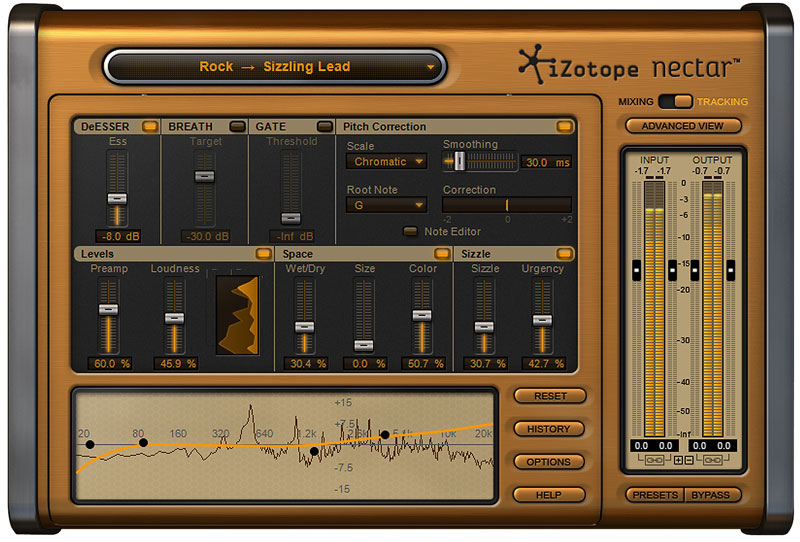- Nectar Vocal Plugin
- Nectar Vocal Suite Review
- Izotope Nectar 2 Vocal Suite Download
- Izotope Nectar Vocal Suite Free Download
- If you want vocals that sit beautifully in your mix, iZotope Nectar 3 Plus is an easy, effective way to make it happen. This indispensable plug-in suite boasts a top-shelf cache of vocal-centric effects modules, including EQ, Harmony, Compressors, Dimension, De-esser, Pitch, Auto Level, Saturation, Reverb, and Gate.
- IZotope Nectar 3 Plus Vocal Production Plug-in Suite Vocal Processing Plug-in with EQ, Harmony, Compressors, Modulation, De-esser, Pitch, Auto Level, Saturation, Reverb, Gate, Vocal Assistant, Unmask, Key Detection, and Melodyne 4 Essential - Mac/PC VST2, VST3, AU, AAX Native $249.00.
Nectar’s 11 processors are organized in presets according to musical Genre and Style.

Nectar Vocal Plugin
Nectar Elements is the easy way to inject your vocals with professional clarity and polish. Packed with robust processing, this plug-in offers compression, de-essing, tonal and subtractive EQ, pitch correction, and reverb — everything you need to make your vocals shine. IZotope Nectar is a complete set of 11 vocal production effects combined in one plug-in that's designed to give you immediate results. Built-in Styles get the grunt work out of the way so you can focus on the creative finishing touches. Nectar 3’s Vocal Assistant creates a custom preset for your vocal to get it to sit right in the mix. Like an extra pair of trusted ears, Vocal Assistant listens to your audio and gets you started by detecting and auto-adjusting level inconsistencies, identifying resonant peaks, timbre variations, and harsh frequencies.

iZotope expands its line of multiprocessor tools with Nectar, a specifically designed plug-in for lead and backing vocal processing. Nectar uses chains of up to 11 processor modules, and comes with a large library of preset combinations that emulate vocal treatments used in many popular musical genres. Processors include pitch correction, breath control, gate, saturation, EQ, compressor, de-esser, doubler, limiter, reverb and delay.
Available as a native plug-in in AU, VST and RTAS formats running on PCs or Mac hosts, Nectar operates in either Mixing or Tracking modes. Mixing mode is full-powered but at a considerable DSP cost. In Tracking mode, Nectar downshifts the pitch correction, doubler and limiter modules to minimal versions, reduces overall latency and disables the high-latency Breath Control module.
WHAT’S YOUR STYLE?
Nectar’s presets are organized into musical Genres and Styles. A Genre in Nectar comprises a certain collection of processor modules used for mixing songs within that musical form. For example, you won’t find Pitch Correction in the Jazz genre, but you would in the Pop genre. Nectar offers presets for more than 10 musical genres, plus effects, voice-over and dialog.
Style designates the module chain order in which they are connected, the initial/default parameter settings and the way the modules interact. There are four to 12 different premade Styles per Genre included. While Styles from one Genre cannot be applied to another Genre, you can use the pop-up editor to create, rename and add your own concoction to your preset list.

When Nectar is first instantiated, a Quick Start main view gets you close to the sound you want quickly. The Preset/Style selector drops down for choosing a Genre and Style. Once selected, a simplified set of controls for each module used in the preset appears so that you can quickly change default settings. Advanced view offers a list of all 11 modules with separate screens for each.
HOW SWEET IT IS!
I tested Nectar in Pro Tools 9 HD3 Accel running on a Mac Westmere 8-core (OS 10.6.6), and at first glance Nectar appeared daunting. But in spite of the power and technical depth, it doesn’t take a scientist to use it. I did find that while in Advanced view if you want to select another Genre/Style, the list drops down so you can’t see the module lineup change as you try different Styles.
One of the most important initial tweaks is input level. The recorded level of vocal tracks makes the biggest difference in the way the compressor, limiter, gate and saturation processors work. The unambiguous and “no-brainer” input control section lets you set level within an acceptable, “bracketed” range.

For a wide lead vocal sound in a boy band mix, I called up the Pop genre and the Cruzing (Male) Style. Because Nectar does not have a mono-to-stereo instance yet, I duplicated my lead vocal track and sent each copy to the left and right side of a stereo aux fader and inserted a stereo instance of Nectar.
Nectar’s Main view showed the Pitch Correction module in chromatic mode with just the correction speed, scale and root note values to adjust. I clicked on the Manual Editor because, in addition to running automatically and reining in wayward pitch, this module let me “scan” problem areas for manual correction, much like Melodyne 3.2.2 or AutoTune 7. Edits are remembered and tied to your particular audio position, and, yes, you can put correction speed to 0 ms and make vocal tracks sound like vocals on Pop radio these days.
The Cruzing (Male) Style produces an aggressive, hot level using the Compressor, Limiter and Saturation modules, but there are only preamp and loudness parameters to set. There was a delay effect called Space with just wet/dry, size and color faders. The Doubler module had a fader for the amount of an added low-octave voice and a Spread control for the other unison voices panned left and right. I liked that there is always a large GUI in Main view for the 5-band parametric equalizer section for immediate click-and-drag tweaks.
Although the macro faders worked well, when I clicked into Advanced view, I could fine-tune the parameters inside each of the modules. For this mix, I found both the Compressor and Limiter modules’ default settings good and aggressive-sounding while easy to dial in.

The Compressor module has two compressors, each with a choice of four compressor types—vintage, digital, optical and solid-state—plus a post-EQ section. I loved using them both in parallel, where you can crossfade mix between a smooth compression and a harder squash. As there is already a fine EQ in Nectar, I think the compressor module’s minimal EQ section would be more useful in the sidechain path.
In the Saturation module, I switched to Tape (there are also Analog, Tube, Retro and Warm positions) and flattened out the highs with its roll-off filter. This smooth-working module is perfectly designed to add just a little vibey grit and “hair” to an overly clean vocal recording.
For a less-electronic sound, I reduced the level of the Doubler effect and automated the low-octave voice only to play during a breakdown section—easy to do with all 153 of Nectar’s automatable parameters.
I liked the De-Esser module because it “chills out” the “s” sounds without killing the vocal overall. Breath Control analyzes the harmonic structure of vocal inhalation/exhalations and acts like a downward expander to suppress them. It works well, although it’s fiddly to set correctly. In Pro Tools with just Breath Control running, Nectar becomes 26,623 samples late, making it an offline AudioSuite process only.
Nectar Vocal Suite Review
In Mixing mode, Nectar—depending greatly on which modules are running—uses considerable host DSP resources and may exceed your DAW’s delay-compensation engine’s ability to correct its latency. So for the most part, unless I needed extensive Pitch Correction and Breath Control, I ran it in Tracking mode.
Izotope Nectar 2 Vocal Suite Download
IT GOES TO 11
With 11 processor modules, Nectar is an excellent, all-purpose, one-stop vocal processor. It replaces the long chains of separate plug-ins I normally use to achieve the same results. Within one plug-in, I have a broad spectrum of effects and processing power made easy to modify and use on vocals. But don’t limit yourself—it works great on drums, bass, guitars and keys, too.
Barry Rudolph is an L.A.-based engineer.
Izotope Nectar Vocal Suite Free Download
Click on the Product Summary box above to view the Nectar product page.
